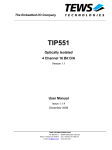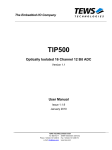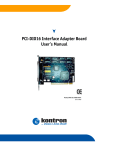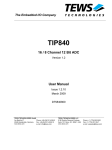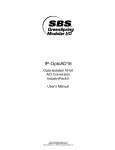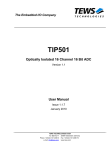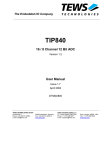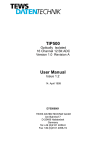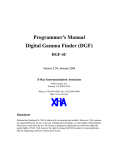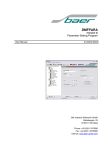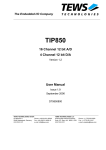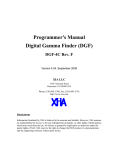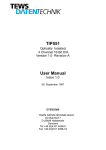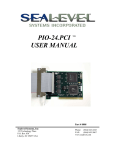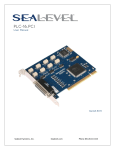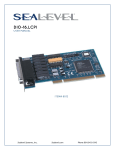Download TIP845
Transcript
The Embedded I/O Company TIP845 48 Channel 14 bit A/D Conversion Version 1.0 User Manual Issue 1.4 October 2005 D75845800 TEWS TECHNOLOGIES GmbH Am Bahnhof 7 Phone: +49-(0)4101-4058-0 e-mail: [email protected] 25469 Halstenbek / Germany Fax: +49-(0)4101-4058-19 www.tews.com TEWS TECHNOLOGIES LLC 1 E. Liberty Street, Sixth Floor Phone: +1 (775) 686 6077 e-mail: [email protected] Reno, Nevada 89504 / USA Fax: +1 (775) 686 6024 www.tews.com TIP845-10 This document contains information, which is proprietary to TEWS TECHNOLOGIES GmbH. Any reproduction without written permission is forbidden. 48 Channel 14 bit A/D Conversion TEWS TECHNOLOGIES GmbH has made any effort to ensure that this manual is accurate and complete. However TEWS TECHNOLOGIES GmbH reserves the right to change the product described in this document at any time without notice. TEWS TECHNOLOGIES GmbH is not liable for any damage arising out of the application or use of the device described herein. Style Conventions Hexadecimal characters are specified with prefix 0x, i.e. 0x029E (that means hexadecimal value 029E). For signals on hardware products, an ‚Active Low’ is represented by the signal name with # following, i.e. IP_RESET#. Access terms are described as: W Write Only R Read Only R/W Read/Write R/C Read/Clear R/S Read/Set 2003-2005 by TEWS TECHNOLOGIES GmbH Issue Description Date 1.0 Initial Issue November 2003 1.1 Changed ADC correction formula, corrected typos April 2004 1.2 Added Programming Note and Installation Note October 2004 1.3 Updated Technical Specification June 2005 1.4 Summarization of Important Notes October 2005 TIP845 User Manual Issue 1.4 Page 2 of 32 Table of Contents 1 2 3 PRODUCT DESCRIPTION ......................................................................................... 5 TECHNICAL SPECIFICATION................................................................................... 6 FUNCTIONAL DESCRIPTION ................................................................................... 7 3.1 Data Correction ...............................................................................................................................7 3.1.1 ADC Correction Formula ......................................................................................................8 4 5 ID PROM CONTENTS ................................................................................................ 9 IP ADDRESSING...................................................................................................... 10 5.1 I/O Addressing...............................................................................................................................10 ADC Register Set..................................................................................................................................11 5.1.1 ADC Control Register CONTREG (Address 0x00) ............................................................11 5.1.2 ADC Data Register DATAREG (Address 0x02) .................................................................13 5.1.3 ADC Status Register STATREG (Address 0x05)...............................................................14 5.1.4 ADC Conversion Start Register (Address 0x07) ................................................................14 5.2 Sequencer Register Set................................................................................................................15 5.2.1 Sequencer Control Register SEQCONT (Address 0x0B) ..................................................15 5.2.2 Sequencer Status Register SEQSTAT (Address 0x0D).....................................................16 5.2.3 Sequencer Timer Register SEQTIMER (Address 0x0E)....................................................17 5.2.4 Sequencer Instruction RAM (Address 0x21…0x4F) ..........................................................17 5.3 Additional Registers .....................................................................................................................20 5.3.1 Interrupt Status Register INTSTAT (Address 0x09) ...........................................................20 5.3.2 Interrupt Vector Register IVEC (Address 0x11) .................................................................20 5.4 Memory Addressing......................................................................................................................20 5.4.1 Sequencer Data RAM SDRAM0-47 (Offset 0x00 to 0x5E) ................................................21 6 OPERATING MODES............................................................................................... 22 6.1 Manual Mode .................................................................................................................................22 6.2 Sequencer Mode ...........................................................................................................................23 6.2.1 Sequencer Errors................................................................................................................24 6.3 Application Examples...................................................................................................................25 6.3.1 Fastest Conversion of an Arbitrary Single Channel ...........................................................25 6.3.2 Fastest Conversion of a Specific Single Channel ..............................................................25 6.3.3 Periodic Conversion of Multiple Channels..........................................................................28 6.3.4 Continuous Conversion of Multiple Channels ....................................................................29 7 8 PIN ASSIGNMENT – I/O CONNECTOR .................................................................. 30 IMPORTANT NOTES ............................................................................................... 32 8.1 Dummy Conversions after Power-up..........................................................................................32 8.2 Open Multiplexer Inputs ...............................................................................................................32 TIP845 User Manual Issue 1.4 Page 3 of 32 Table of Figures FIGURE 1-1 : BLOCK DIAGRAM......................................................................................................................5 FIGURE 2-1 : TECHNICAL SPECIFICATION...................................................................................................6 FIGURE 4-1 : ID PROM CONTENTS ...............................................................................................................9 FIGURE 5-1 : REGISTER SET .......................................................................................................................10 FIGURE 5-2 : ADC CONTROL REGISTER ....................................................................................................12 FIGURE 5-3 : ADC DATA REGISTER ............................................................................................................13 FIGURE 5-4 : ADC DATA CODING ................................................................................................................13 FIGURE 5-5 : ADC STATUS REGISTER .......................................................................................................14 FIGURE 5-6 : SEQUENCER CONTROL REGISTER.....................................................................................15 FIGURE 5-7 : SEQUENCER STATUS REGISTER ........................................................................................16 FIGURE 5-8 : SEQUENCER INSTRUCTION RAM ADDRESSING ...............................................................17 FIGURE 5-9 : SEQUENCER INSTRUCTION BYTE BREAKDOWN ..............................................................17 FIGURE 5-10: SEQUENCER INSTRUCTION RAM .......................................................................................19 FIGURE 5-11: INTERRUPT STATUS REGISTER .........................................................................................20 FIGURE 5-12: INTERRUPT VECTOR REGISTER ........................................................................................20 FIGURE 5-13: SEQUENCER DATA RAM ......................................................................................................21 FIGURE 5-14: SEQUENCER DATA RAM LOCATIONS ................................................................................21 FIGURE 6-1 : SEQUENCER ERRORS ..........................................................................................................24 FIGURE 6-2 : FLOW OF FASTEST CONVERSION OF AN ARBITRARY SINGLE CHANNEL ....................25 FIGURE 6-3 : FLOW OF FASTEST CONVERSION OF A SPECIFIC SINGLE CHANNEL ...........................27 FIGURE 6-4 : FLOW OF PERIODIC CONVERSION OF MULTIPLE CHANNELS ........................................28 FIGURE 6-5 : FLOW OF CONTINUOUS CONVERSION OF MULTIPLE CHANNELS .................................29 FIGURE 7-1 : PIN ASSIGNMENT I/O CONNECTOR.....................................................................................31 TIP845 User Manual Issue 1.4 Page 4 of 32 1 Product Description The TIP845 is an IndustryPack® compatible module providing 48 single-ended or 24 differential ADC input channels. The data acquisition and conversion time is up to 2.5µs without channel / gain change and up to 10.5µs with channel / gain change. The resolution is 14 bit. The input multiplexer of the A/D circuit offers analog overvoltage protection of up to 70Vpp. A programmable gain amplifier allows gains of 1, 2, 4 or 8 resulting in input voltage ranges of +/-10V, +/5V, +/-2.5V or +/-1.25V. Additionally the TIP845 provides a sequencer to control the analog inputs without wasting CPU time. Each of the A/D channels can be independently enabled and configured by a sequencer instruction RAM. After the last instruction of a programmed sequence has completed, the ADC data of all enabled channels are stored in the data RAM. The repeat frequency of the sequencer can be programmed by using the sequence timer. The sequence timer is programmable from 100µs to 6.5535s in steps of 100µs. The sequencer starts a new sequence whenever the timer reaches the programmed value. A special function is the sequencer continuous mode. It is activated by setting the Sequence Timer Register to ‘0’. In this mode the sequencer will start again with the first instruction of the sequence as soon as the last instruction of the previous sequence has been completed. An interrupt can be generated at end-of-settling, end-of-conversion or end-of-sequencer cycle supporting an 8 bit vector. Each TIP845 is factory calibrated. The calibration information is stored in the Identification-PROM unique to each IP. Figure 1-1 : Block Diagram TIP845 User Manual Issue 1.4 Page 5 of 32 2 Technical Specification IP Interface Interface Single Size IndustryPack Logic Interface compliant to ANSI/VITA 4-1995 ID ROM Data Format I 1 wait state I/O Space Used with no wait states Memory Space Used with 1 wait state Interrupts Int0 used / Int1 not used DMA Not supported Clock Rate 8 MHz Module Type Type I I/O Interface Number of Analog Inputs 48 single-ended or 24 differential channels Input Gain Amplifier Programmable for gain 1, 2, 4 and 8 Input Voltage Range ±10V for gain = 1 ±5V for gain = 2 ±2.5V for gain = 4 ±1.25V for gain = 8 Input Overvoltage Protection 70Vpp Calibration Data Calibration data for gain and offset correction in ID PROM Conversion Time 2.5µs without channel/gain change 10.5µs with channel/gain change 8µs in sequencer mode ADC Resolution 14 bit with no missing codes ADC INL/DNL Error ±2/±1 LSB Interface Connector 50-conductor flat cable Power Requirements 140mA typical @ +5V DC Physical Data Temperature Range Operating Storage -40°C to +85 °C -40°C to +125°C MTBF 738000 h Humidity 5 – 95 % non-condensing Weight 31 g Figure 2-1 : Technical Specification TIP845 User Manual Issue 1.4 Page 6 of 32 3 Functional Description The TIP845-10 provides 48 single-ended or 24 differential multiplexed analog inputs. The desired input channel and the mode (single-ended or differential) are selected by programming the input multiplexer. A software programmable gain amplifier with gain settings of 1, 2, 4 and 8 allows a direct connection of a wide range of sensors and instrumentation. The maximum analog input voltage range is ±10V at a gain of 1. Because the TIP845 is a multiplexed analog input system, a settling time is required to pass after changing the input channel and / or gain. The TIP845 provides a status bit for polling the settling time status. An Automatic Settling Time Control Mode is also provided. In this mode, data conversion is automatically started after the settling time has elapsed. The absolute accuracy of the module can be increased by performing a data correction in software, using the factory calibration factors stored in the on board ID PROM. 3.1 Data Correction There are two errors which affect the DC accuracy of the ADC. • ADC Offset Error: The Offset Error is the data value if converting with the connected input to its own ground in single-ended mode, or with shorted inputs in differential mode. This error is corrected by subtracting the known error from the Readings. • ADC Gain Error: The Gain Error is the difference between the ideal gain and the actual gain of the programmable gain amplifier and the ADC. It is corrected by multiplying the Reading with a correction factor. The data correction values are obtained during factory calibration and are stored in the modules individual version of the ID PROM. The ADC has a pair of offset and gain correction values for each of the programmable gains. The offset and gain error values are the same for all channel 1-48. TIP845 User Manual Issue 1.4 Page 7 of 32 3.1.1 ADC Correction Formula Please use the total 16 bit data register value for the ADC correction formula. The basic formula for correcting any ADC reading for the TIP845-10 (bipolar input voltage range) is: Value = Reading ⋅ 1 − Gaincorr − Offsetcorr 32768 Value is the corrected result. Reading is the data read from the ADC Data Register. Gaincorr and Offsetcorr are the correction factors from the ID PROM stored for each gain factor. The correction values are stored as two’s complement 8 bit values in the range -128 to 127. For higher accuracy they are scaled to ¼ LSB. Floating point arithmetic or scaled integer arithmetic is necessary to avoid rounding error while computing above formula. TIP845 User Manual Issue 1.4 Page 8 of 32 4 ID PROM Contents Address Function Contents 0x01 ASCII ‘I’ 0x49 0x03 ASCII ‘P’ 0x50 0x05 ASCII ‘A’ 0x41 0x07 ASCII ‘C’ 0x43 0x09 Manufacturer ID 0xB3 0x0B Model Number 0x39 0x0D Revision 0x10 0x0F Reserved 0x00 0x11 Driver-ID Low - Byte 0x00 0x13 Driver-ID High - Byte 0x00 0x15 Number of bytes used 0x17 CRC 0x19 Offset Error Gain 1 Board dependent 0x1B Offset Error Gain 2 Board dependent 0x1D Offset Error Gain 4 Board dependent 0x1F Offset Error Gain 8 Board dependent 0x21 Gain Error Gain 1 Board dependent 0x23 Gain Error Gain 2 Board dependent 0x25 Gain Error Gain 4 Board dependent 0x27 Gain Error Gain 8 Board dependent 0x29…0x3F 0x14 variable Not used Figure 4-1 : ID PROM Contents The ID PROM data is available 200 µs after reset. TIP845 User Manual Issue 1.4 Page 9 of 32 5 IP Addressing 5.1 I/O Addressing The TIP845 is controlled by a set of registers which are directly accessible in the I/O space of the IP module. Address Symbol Description Size (Bit) Access 0x00 CONTREG ADC Control Register 16 R/W 0x02 DATAREG ADC Data Register 16 R 0x05 STATREG ADC Status Register 8 R 0x07 CONVERT ADC Conversion Start Register 8 W 0x09 INTSTAT Input Interrupt Status Register 8 R/W 0x0B SEQCONT Sequencer Control Register 8 R/W 0x0D SEQSTAT Sequencer Status Register 8 R/W 0x0E SEQTIMER Sequencer Timer Register 16 R/W 0x11 IVEC Interrupt Vector Register 8 R/W 0x12.. 0x20 - Reserved, do not write - - 0x21.. 0x4F SIRAM1-24 Sequencer Instruction RAM 24 x byte R/W Figure 5-1 : Register Set TIP845 User Manual Issue 1.4 Page 10 of 32 ADC Register Set 5.1.1 ADC Control Register CONTREG (Address 0x00) Bit Symbol Description Access Reset Value 15:12 - Reserved Write: don't care Read: always reads as '0' R 0 11 IRQC IRQ after Conversion 0 = No interrupt generation after finished conversion 1 = Interrupt generation after finished conversion R/W 0 10 IRQST IRQ after Settling Time 0 = No interrupt generation after settling time has elapsed 1 = Interrupt generation after settling time has elapsed R/W 0 9 ASTC Automatic Settling Time Control 0 = OFF (Normal Mode) A conversion must be initiated manually in the CONVERT register 1 = ON (Automatic Mode) A conversion is automatically initiated after the settling time has elapsed. The settling time for the TIP845 is appr. 8µs R/W 0 8:7 GAIN[1:0] Gain Selection (Analog Input Amplifier) R/W 00 R/W 0 6 SE/DIFF GAIN1 GAIN0 Gain Factor Input Voltage Range 0 0 1 0 1 2 ±5V 1 0 4 ±2.5V 1 1 8 ±1.25V ±10V Single/Differential Mode Control 0 = Single-ended mode 48 single-ended input channels available 1 = Differential mode 24 differential input channels available Mixed modes are possible TIP845 User Manual Issue 1.4 Page 11 of 32 Bit Symbol Description Access Reset Value 5:0 CS[5:0] Channel Select (Analog Input Channel) R/W 0x3F CS[5:0] Single-ended Channel SE/DIFF = 0 Differential Channel SE/DIFF = 1 000000 CH1 CH1 … … … 010111 CH24 CH24 011000 CH25 N/A … … … 101111 CH48 N/A 110000 N/A N/A … … … 111111 N/A N/A ‘N/A’ = ADC Input connected to GND Figure 5-2 : ADC Control Register A write to this register sets the new channel and gain. Subsequent write accesses are ignored until the settling time has elapsed. To change both channel and gain, or to archive a full channel setup, a word access is recommended. TIP845 User Manual Issue 1.4 Page 12 of 32 5.1.2 ADC Data Register DATAREG (Address 0x02) The ADC Data Register contains the converted data value. Output coding is two’s complement binary (1 LSB = FSR/16384 = 1.22 mV for the ±10 V range). This 14 bit ADC value is shifted to the higher bits of the register by hardware. This allows direct processing of the data as a 16 bit two's complement integer value. Description Access Reset Value 15:2 Stores the converted 14 bit data value, shifted by hardware to the higher bits R 0 1:0 Always read as '0' R 0 Bit Symbol Figure 5-3 : ADC Data Register Description Full Scale (pos.) … Shifted ADC Data Value 0x7FFC … Midscale + 1 LSB 0x0004 Midscale 0x0000 Midscale – 1 LSB 0xFFFC … … Full Scale (neg.) 0x8000 Figure 5-4 : ADC Data Coding TIP845 User Manual Issue 1.4 Page 13 of 32 5.1.3 ADC Status Register STATREG (Address 0x05) Bit Symbol Description Access Reset Value 7:2 - Reserved Read: always read as '0' R 000000 1 SETTL BUSY SETTL_BUSY Indicates that the required settling time after a write to the CONTREG register is not yet done. If Automatic Settling Time Mode is OFF, this bit is set by writing to the CONTREG register. The bit is cleared if the required settling time has elapsed. This bit must be read as '0' before a conversion is started by a write to the CONVERT register. The settling time for the TIP845 is appr. 8µs R 0 0 ADC BUSY ADC_BUSY Indicates if an actual data conversion is in progress. If Automatic Settling Time Mode is OFF, this bit is set by writing to the CONVERT register. If Automatic Settling Time Mode is ON, this bit is set automatically after the settling time has elapsed. This bit must be read as '0' before the conversion data is read from the DATAREG register. R 0 Figure 5-5 : ADC Status Register 5.1.4 ADC Conversion Start Register (Address 0x07) The ADC Conversion Start Register CONVERT is an 8 bit wide write only register. The ADC Conversion Start Register is used to start an ADC conversion if Automatic Settling Time Mode is OFF. The user must read the SETTL_BUSY bit in the ADC Status Register as '0' before the conversion is started. The ADC_BUSY bit in the ADC Status Register indicates if the conversion data in the ADC Data Register is valid (ADC_BUSY bit = '0'). It is allowed to set up a new channel/gain by writing to the ADC Control Register CONTREG immediately after starting an ADC conversion. If Sequencer Mode is selected (SEQCONT Register bit 0 is set to ‘1’) a write access to the ADC Conversion Start Register is ignored. Please pay attention to the chapter “Important Notes”. TIP845 User Manual Issue 1.4 Page 14 of 32 5.2 Sequencer Register Set 5.2.1 Sequencer Control Register SEQCONT (Address 0x0B) Bit Symbol Description Access Reset Value 7:2 - Reserved Write: don't care Read: always reads as '0' R 0 1 SEQ INT ENA Sequencer Interrupt Enable Control 0 = Sequencer interrupt disabled 1 = Sequencer interrupt enabled An interrupt request will be generated if any bit is set in the SEQSTAT register (sequencer data valid or sequencer error). R/W 0 0 SEQ ON Sequencer Start / Stop Control 0 = Stops the sequencer after the last instruction 1 = Starts the sequencer immediately R/W 0 Figure 5-6 : Sequencer Control Register If an error flag is set in the Sequencer Status Register SEQSTAT, the sequencer will be stopped after the last instruction (SEQ_ON will be set to '0'). The user must clear the status bits and start the sequencer again. Please pay attention to the chapter “Important Notes” before using the sequencer. TIP845 User Manual Issue 1.4 Page 15 of 32 5.2.2 Sequencer Status Register SEQSTAT (Address 0x0D) Bit Symbol Description Access Reset Value 7:4 - Reserved Write: don't care Read: always reads as '0' R 0 3 I-RAM ERROR Instruction RAM Error Flag Set by the sequencer if the sequencer has been started and there is no correct instruction in the Instruction RAM. To clear this flag the user must write ‘1’ to this bit. R/W 0 2 TIMER ERROR Time Error Flag Set by the sequencer if the sequencer timer has elapsed but the actual sequence is still in progress. To clear the Timer Error Flag the user must write ‘1’ to this bit. If the Sequencer Timer Register is 0 (Sequencer Continuous Mode) the Timer Error Flag always read as ‘0’. R/W 0 1 DATA OF ERROR Data Overflow Error Flag Set by the sequencer if the last sequencer instruction is done and the Data Available Flag of the previous sequence has not yet been cleared by the user. To clear the error flag the user must write ‘1’ to this bit. If the Sequencer Timer Register is 0 (Sequencer Continuous Mode) the Data Overflow Error Flag always read as ‘0’. R/W 0 0 DATA AV Data Available Flag Set if a sequence is done and new ADC Data is available in the ADC Data RAM. After reading the ADC Data RAM the user must clear the Data Available Flag by writing ‘1’ to this bit. R/W 0 Figure 5-7 : Sequencer Status Register As long as any of the bits [3:1] (error flags) of the Sequencer Status Register SEQSTAT is read as ‘1’, the sequencer will be stopped after the last instruction (SEQ_ON will be set to '0'). The user must clear the status bit and start the sequencer again. TIP845 User Manual Issue 1.4 Page 16 of 32 5.2.3 Sequencer Timer Register SEQTIMER (Address 0x0E) The Sequencer Timer Register SEQTIMER is a 16 bit wide read/write register. The Sequence Timer is programmable from 100µs to 6.5535s in 100µs steps. Whenever the timer reaches the programmed value the sequencer starts a new sequence with the first instruction found in the instruction RAM. Assure that the needed time to complete a sequence is suitable to the chosen sequence timer value. If the sequence timer elapses while a sequence is still in progress, a timer error will be asserted. If the Sequencer Timer Register is set to ‘0’, the Sequencer Continuous Mode is selected. The sequencer will start again with the first instruction of the sequence immediately after the last instruction of the previous sequence has been completed. 5.2.4 Sequencer Instruction RAM (Address 0x21…0x4F) The Sequencer Instruction RAM is a 24 x 8 bit wide RAM which is accessible in the I/O space. In each sequencer instruction byte configures either one differential ADC channel or two single-ended ADC channels. The following table shows which sequencer instruction byte is allocated to which channels: SIRAM Address Diff. Channel SE Channels A B SIRAM Address Diff. Channel SE Channels A B 0x21 1 1 2 0x39 13 25 26 0x23 2 3 4 0x3B 14 27 28 0x25 3 5 6 0x3D 15 29 30 0x27 4 7 8 0x3F 16 31 32 0x29 5 9 10 0x41 17 33 34 0x2B 6 11 12 0x43 18 35 36 0x2D 7 13 14 0x45 19 37 38 0x2F 8 15 16 0x47 20 39 40 0x31 9 17 18 0x49 21 41 42 0x33 10 19 20 0x4B 22 43 44 0x35 11 21 22 0x4D 23 45 46 0x37 12 23 24 0x4F 24 47 48 Figure 5-8 : Sequencer Instruction RAM addressing Each sequencer instruction byte is subdivided into following parts: Sequencer Instruction Byte Bits [6:4] Bits [3:0] Differential configuration Ignored Differential Channel Single-ended configuration Single-Ended Channel B Single-Ended Channel A Figure 5-9 : Sequencer Instruction Byte breakdown TIP845 User Manual Issue 1.4 Page 17 of 32 Examples: To configure single-ended channel 3 to gain 2 and single-ended channel 4 to gain 1 write 0x16 to SIRAM address 0x23. To configure channel 3 as differential channel with gain 4, write 0x0B to SIRAM address 0x23. By configuration Channel 4 is not available and any settings for channel 27 are ignored. Bit Symbol Description Access Power-up Value 7 - Reserved Write: don't care Read: always reads as '0' R 0 6:5 GAIN[1:0] Single-Ended Channel B: Gain Selection (Analog Input Amplifier) R/W 00 GAIN1 GAIN0 Gain Factor Input Voltage Range 0 0 1 ±10V 0 1 2 ±5V 1 0 4 ±2.5V 1 1 8 ±1.25V If SE/DIFF = '1', this bits are ignored. 4 ENA Single-Ended Channel B: Enable the ADC Channel for the sequencer 0 = Sequencer will pass over the ADC Channel 1 = Sequencer converts the ADC Channel and updates the ADC Data in the Sequencer Data RAM at the end of the sequence. If SE/DIFF = '1', this bit is ignored. R/W 0 3:2 GAIN[1:0] Single-Ended Channel A / Differential Channel: Gain Selection (Analog Input Amplifier) R/W 00 R/W 0 1 ENA GAIN1 GAIN0 Gain Factor Input Voltage Range 0 0 1 ±10V 0 1 2 ±5V 1 0 4 ±2.5V 1 1 8 ±1.25V Single-Ended Channel A / Differential Channel: Enable the ADC Channel for the sequencer 0 = Sequencer will pass over the ADC Channel 1 = Sequencer converts the ADC Channel and updates the ADC Data in the Sequencer Data RAM at the end of the sequence. If SE/DIFF = '1', this bit enables the differential channel. Example: If only channel 1, channel 2 and channel 8 are enabled, only the three ADC RAM locations for channel 1, channel 2 and channel 8 are updated at the end of the sequence. The user must only read these three ADC RAM locations then. TIP845 User Manual Issue 1.4 Page 18 of 32 Bit Symbol Description Access Power-up Value 0 SE/DIFF Single/Differential Mode Control 0 = Single-ended mode 48 single-ended channels available 1 = Differential mode 24 differential channels 1 to 24 available Mixed mode is possible. E.g. channel 1 to channel 8 selected as differential inputs (equivalent to singleended inputs 1-16), and channel 17 to channel 48 as single-ended input channels. R/W 0 Figure 5-10: Sequencer Instruction RAM The Sequencer Instruction RAM is not cleared by a reset. Be sure to set up the entire Sequencer Instruction RAM if it is used after a reset. TIP845 User Manual Issue 1.4 Page 19 of 32 5.3 Additional Registers 5.3.1 Interrupt Status Register INTSTAT (Address 0x09) Bit Symbol Description Access Reset Value 7:3 - Reserved Write: don't care Read: always reads as '0' R 0 2 SEQ READY Sequencer Interrupt Pending Flag (bit is controlled by the sequencer logic) If sequencer interrupts are enabled (SEQCONT register bit 1 set to '1’) and a sequencer interrupt is pending (any of the SEQSTAT register bits [3:0] is ‘1’) the sequencer interrupt pending flag is read as ‘1’. The interrupt is cleared by writing ’1’ to the corresponding status bits in the SEQSTAT register. R/W 0 1 SETTL READY SETTL_READY Interrupt Flag (bit is controlled by the settling time controller) If interrupts are enabled (CONTREG register bit 10 is set to ‘1’) and Automatic Settling Time Mode is OFF (CONTREG register bit 8 is set to ‘0’) this interrupt is generated, if the settling time is expired. The interrupt is cleared by writing ’1’ to this bit. R/W 0 0 ADC READY ADC_READY Interrupt Flag (bit is controlled by the ADC controller) If interrupts are enabled (CONTREG register bit 11 is set to ‘1’) this interrupt is generated, if a data conversion is done. The interrupt is cleared by writing ’1’ to this bit. R/W 0 Figure 5-11: Interrupt Status Register 5.3.2 Interrupt Vector Register IVEC (Address 0x11) Bit Symbol Description Access Reset Value 7:0 IVEC Interrupt Vector R/W 0 Figure 5-12: Interrupt Vector Register 5.4 Memory Addressing In Sequencer Mode the converted ADC data is accessible in the IP Memory Space. TIP845 User Manual Issue 1.4 Page 20 of 32 5.4.1 Sequencer Data RAM SDRAM0-47 (Offset 0x00 to 0x5E) The Sequencer Data RAM is a 48 x 16 bit wide RAM storing the converted data values. Address Symbol Description Size (Bit) Access 0x00… 0x5E SDRAM148 Sequencer Data RAM 48 x 16 R Figure 5-13: Sequencer Data RAM Each channel has its own ADC Data location. Address Symbol Description Size (Bit) Access 0x00 SDRAM1 Differential Channel 1 / Single-Ended Channel 1 16 R 0x02 SDRAM2 Single-Ended Channel 2 16 R 0x04 SDRAM3 Differential Channel 2 / Single-Ended Channel 3 16 R 0x06 SDRAM4 Single-Ended Channel 4 16 R … … … … … 0x2C SDRAM23 Differential Channel 12 / Single-Ended Channel 23 16 R 0x2E SDRAM24 Single-Ended Channel 24 16 R 0x30 SDRAM25 Differential Channel 13 / Single-Ended Channel 25 16 R 0x32 SDRAM26 Single-Ended Channel 26 16 R … … … … … 0x58 SDRAM45 Differential Channel 23 / Single-Ended Channel 45 16 R 0x5A SDRAM46 Single-Ended Channel 46 16 R 0x5C SDRAM47 Differential Channel 24 / Single-Ended Channel 47 16 R 0x5E SDRAM48 Single-Ended Channel 48 16 R Figure 5-14: Sequencer Data RAM locations Note that only enabled channels in the Sequencer Instruction RAM are updated. Channels that are not enabled in the Sequencer Instruction RAM are not updated and may contain invalid data from former conversions. The Sequencer Data RAM is not cleared by a reset and may contain invalid data from former conversions. Word accesses are recommended to read this registers. TIP845 User Manual Issue 1.4 Page 21 of 32 6 Operating Modes There are two modes of operation: the Manual Mode, with little or none support through automation, and the Sequencer Mode, with large support through automation. • Manual Mode In this mode, the converter operation relies on the user. The channel and gain are set by the user, and the user has large influence on the converter operation. Use this mode to convert specific channels and to control conversion timing or to read a channel repeatedly without the need to await the settling time. • Sequencer Mode In this mode almost everything is automated and the converter operation is transparent to the user. Use this mode to convert all channels at specific time intervals, or to have always current data available. 6.1 Manual Mode The Manual Mode is useful, if direct control of converter operation is needed. Setup the desired channel and gain by writing to the CONTREG register. If the Automatic Settling Time Control is deactivated, the user has to wait until the ADC_SETTL flag reads '0'. Then the conversion can be started by writing to the CONVERT register. If the Automatic Settling Time Control is activated, the conversion starts automatically after the settling time has elapsed. It is possible to select the next channel and/or gain by writing to the CONTREG register immediately after the write to the CONVERT register. Then the conversion and the settling time will proceed simultaneously. The conversion data is available in the DATAREG register if the ADC_BUSY flag in the STATREG register reads as '0'. If interrupts are enabled, two interrupts will be generated: the first interrupt is generated if the settling time has elapsed (and the Automatic Settling Time Control is deactivated); the second interrupt is generated if the conversion has finished. Using the interrupts exempts from polling the ADC_SETTL and ADC_BUSY flags. Without Automatic Settling Time Control: ! Setup the conversion in the ADC Control Register ! Poll for SETTL_BUSY flag ! After settling time has elapsed, write to the CONVERT register to start conversion ! Poll for ADC_BUSY flag ! After conversion time has elapsed, read conversion data in the ADC Data Register TIP845 User Manual Issue 1.4 Page 22 of 32 With Automatic Settling Time Control: ! Setup the conversion in the ADC Control Register ! Poll for SETTL_BUSY flag ! Poll for ADC_BUSY flag ! After conversion time has elapsed, read conversion data in the ADC Data Register 6.2 Sequencer Mode The Sequencer Mode is very useful for periodic measurements or to always provide actual conversion data. The sequencer converts all enabled ADC channels and stores the results in the Sequencer Data RAM. After a programmable time the sequencer repeats the sequence. To use the sequencer, all channels must be configured for the sequence in the Sequencer Instruction RAM. In the Sequencer Instruction RAM the channels are enabled for the sequence, and the gain and the mode (single-ended or differential) are selected. Once the sequencer is started, all enabled channels are converted and the results are stored in the Sequencer Data RAM. If the last sequencer instruction has been completed, the Data Available Flag DATA_AV in the Sequencer Status Register (SEQSTAT) is set to '1' and, if enabled, an interrupt request will be asserted. The user can now read the ADC data from the Sequencer Data RAM. Afterwards the DATA_AV flag must be cleared by writing a '1' to the Sequencer Status Register SEQSTAT bit 0. Only the enabled channels are updated; not enabled channels in the Sequencer Instruction RAM are not updated and may contain invalid data from former conversions. The repeat frequency of the sequencer can be programmed in the Sequencer Timer Register. The Sequencer Timer is programmable from 100µs to 6.5535s in steps of 100µs. Whenever the timer reaches the programmed value the sequencer starts a new sequence. A special function is the Sequencer Continuous Mode. It is activated if the Sequencer Timer Register is set to 0x0000. In this mode the sequencer immediately starts a new sequence if the actual sequence has been completed. If the sequencer is in Sequencer Continuous Mode, the user can read valid data from the Sequencer Data RAM at any time. The Sequencer Data RAM locations of the enabled ADC channels are updated with every sequence. If the Sequencer Continuous Mode is active, the Data Overflow Error Flag DATA_OF_ERROR is deactivated and always reads as '0'. Clearing the Data Available Flag DATA_AV is not necessary in the Sequencer Continuous Mode, but it is recommended to monitor the completion of the sequences. The update rate depends on the number of enabled channels: Update Rate = 8µs · number of enabled channels TIP845 User Manual Issue 1.4 Page 23 of 32 6.2.1 Sequencer Errors If the sequencer detects an error, it will stop after the last instruction and sets the corresponding error flag in the Sequencer Status Register SEQSTAT. Error Description Data Overflow Error occurs if the Error sequencer has new data to store but the user has not yet acknowledged that the data from the previous sequence has been read out. (Sequencer Timer Mode only) Timer Error Sequencer Action User Action Sequencer stops after the last instruction is done. Write a ‘1’ to the Sequencer Status Register bit 1. Data Overflow Error Flag is set. Make sure the Sequencer Data is read and acknowledged within the programmed sequence time. If it is enabled, an interrupt request will be asserted. Start sequencer again. Error occurs if the Sequencer stops after the programmed sequencer last instruction is done. time is shorter than the sequence itself. Timer Error Flag is set. (Sequencer Timer Mode If it is enabled, an interrupt only) request will be asserted. Instruction RAM Error Error occurs if no channel is enabled for the sequence (bit 1 or bit 4 of sequencer Instruction RAM word) and the sequencer is started. Write a ‘1’ to the Sequencer Status Register bit 2. Program a longer sequence time. Start sequencer again. Sequencer stops after the last instruction is done. Write a ‘1’ to the Sequencer Status Register bit 3. Instruction RAM Error Flag is set. Correct the Sequencer Instruction RAM setting. If it is enabled, an interrupt request will be asserted. Start sequencer again. Figure 6-1 : Sequencer Errors If the Sequence Timer Register is set to 0x0000 (Sequencer Continuous Mode) the sequencer ignores the data overflow. The Data Overflow Error Flag is always read as ‘0’ in this mode. TIP845 User Manual Issue 1.4 Page 24 of 32 6.3 Application Examples All following examples use interrupts. The use of interrupts can be replaced by polling the according status flags in the ADC Status Register or the Sequencer Status Register. 6.3.1 Fastest Conversion of an Arbitrary Single Channel ! Program the desired channel and gain in the ADC Control Register CONTREG. Activate the Automatic Settling Time Control (ASTC = '1') and the IRQ after conversion (IRQC = '1') ! The channel is now converted without any further user action. After completion of the conversion an interrupt is issued which signals that the conversion data is available in the DATAREG Register ! Acknowledge the interrupt in the Interrupt Status Register INTSTAT (ADC_READY = '1') and read DATAREG Figure 6-2 : Flow of fastest conversion of an arbitrary single channel Conversion time is approx. 10.5µs. 6.3.2 Fastest Conversion of a Specific Single Channel ! Program the ADC Control Register with desired channel and gain, and activate the IRQ after Settling Time (IRQS = '1'), and the IRQ after conversion (IRQC = '1'). TIP845 User Manual Issue 1.4 Page 25 of 32 ! If the IRQ after settling time is issued, the channel is ready for conversion. Write to the CONVERT register and acknowledge the interrupt in the Interrupt Status Register INTSTAT (SETTL_READY = '1'). ! After completion of the conversion an interrupt is issued which signals that the conversion data is available in the DATAREG register. ! Write again to the CONVERT register to start the next conversion of this channel, acknowledge the interrupt in the Interrupt Status Register INTSTAT (ADC_READY = '1') and read DATAREG. TIP845 User Manual Issue 1.4 Page 26 of 32 Figure 6-3 : Flow of fastest conversion of a specific single channel Conversion time is approx 2.5µs, as long as neither the channel nor the gain is changed. TIP845 User Manual Issue 1.4 Page 27 of 32 6.3.3 Periodic Conversion of Multiple Channels ! Activate the channels to be converted and program the gain in the Sequencer Instruction RAM. ! Set the sequencer period in the Sequencer Timer Register SEQTIMER. ! Enable the Sequencer Interrupt SEQ_INT_ENA and start the sequencer in the Sequencer Control Register SEQCONT. ! After completion of the sequence an interrupt is issued which signals that the conversion data is available in the Sequencer Data RAM. ! Acknowledge the interrupt in the Interrupt Status Register INTSTAT (SEQ_READY = '1'), clear the DATA_AV flag in the Sequencer Status Register and read the Sequencer Data RAM. Figure 6-4 : Flow of periodic conversion of multiple channels TIP845 User Manual Issue 1.4 Page 28 of 32 6.3.4 Continuous Conversion of Multiple Channels ! Activate the channels to be converted and program the gain and mode of these channels in the Sequencer Instruction RAM. ! Set the Sequencer Timer Register SEQTIMER to 0x0000. ! Start the sequencer in the Sequencer Control Register SEQCONT. ! Read the data from the Sequencer Data RAM as needed. Figure 6-5 : Flow of continuous conversion of multiple channels TIP845 User Manual Issue 1.4 Page 29 of 32 7 Pin Assignment – I/O Connector Pin Differential mode Single-ended mode 1 ADC Input 1+ ADC Input 1 2 ADC Input 1- ADC Input 2 3 ADC Input 2+ ADC Input 3 4 ADC Input 2- ADC Input 4 5 ADC Input 3+ ADC Input 5 6 ADC Input 3- ADC Input 6 7 ADC Input 4+ ADC Input 7 8 ADC Input 4- ADC Input 8 9 ADC Input 5+ ADC Input 9 10 ADC Input 5- ADC Input 10 11 ADC Input 6+ ADC Input 11 12 ADC Input 6- ADC Input 12 13 ADC Input 7+ ADC Input 13 14 ADC Input 7- ADC Input 14 15 ADC Input 8+ ADC Input 15 16 ADC Input 8- ADC Input 16 17 ADC Input 9+ ADC Input 17 18 ADC Input 9- ADC Input 18 19 ADC Input 10+ ADC Input 19 20 ADC Input 10- ADC Input 20 21 ADC Input 11+ ADC Input 21 22 ADC Input 11- ADC Input 22 23 ADC Input 12+ ADC Input 23 24 ADC Input 12- ADC Input 24 25 GND GND 26 GND GND 27 ADC Input 13+ ADC Input 25 28 ADC Input 13- ADC Input 26 29 ADC Input 14+ ADC Input 27 30 ADC Input 14- ADC Input 28 31 ADC Input 15+ ADC Input 29 32 ADC Input 15- ADC Input 30 33 ADC Input 16+ ADC Input 31 34 ADC Input 16- ADC Input 32 35 ADC Input 17+ ADC Input 33 36 ADC Input 17- ADC Input 34 37 ADC Input 18+ ADC Input 35 38 ADC Input 18- ADC Input 36 39 ADC Input 19+ ADC Input 37 TIP845 User Manual Issue 1.4 Page 30 of 32 Pin Differential mode Single-ended mode 40 ADC Input 19- ADC Input 38 41 ADC Input 20+ ADC Input 39 42 ADC Input 20- ADC Input 40 43 ADC Input 21+ ADC Input 41 44 ADC Input 21- ADC Input 42 45 ADC Input 22+ ADC Input 43 46 ADC Input 22- ADC Input 44 47 ADC Input 23+ ADC Input 45 48 ADC Input 23- ADC Input 46 49 ADC Input 24+ ADC Input 47 50 ADC Input 24- ADC Input 48 Figure 7-1 : Pin Assignment I/O Connector TIP845 User Manual Issue 1.4 Page 31 of 32 8 Important Notes 8.1 Dummy Conversions after Power-up After power-up the ADC’s logic will be in a random state and may not perform correctly. This has two consequences: 1. The first conversion results are not valid and should be ignored. 2. The ADC starts in a mode that prevents a correct start of the sequencer. Therefore, two dummy conversions are required after each power-up, whose results should be ignored. Use the ADC Conversion Start Register (CONVERT) Register to perform the dummy conversions. If the sequencer is to be used, these two dummy conversions are absolutely necessary. If one of our software drivers is used, these two dummy conversions are already included. 8.2 Open Multiplexer Inputs Unused Multiplexer inputs can pick up stray signals which are injected into the device’s substrate. This turns on spurious substrate devices which badly degrade the performance of the whole multiplexer device. Make sure that all unused analog input pins are tied to the analog ground signal level (or any other valid signal level within the analog input voltage range). This is required even if the unused channels are turned off by software. TIP845 User Manual Issue 1.4 Page 32 of 32
































